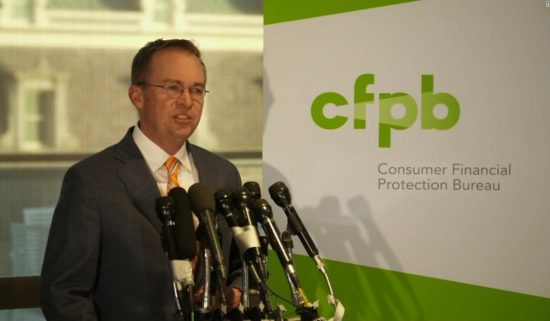
President Trump promised changes in Washington upon his election. Whether you are a Trump fan or foe, there’s no question he’s succeeded in that goal. Sometimes the change is precipitated by the President’s choice to lead an agency, as in the case of the Consumer Financial Protection Bureau (CFPB).
The CFPB was born out of the Dodd-Frank legislation in 2010 as a vehicle to both regulate banks after the Great Recession and protect consumers from harmful and predatory financial practices.
The CFPB was intentionally structured to be independent of political forces. Its money comes from the Federal Reserve, not Congress.
Five-Year Term
The agency director is appointed by the President to a five-year term and can only be fired by the President for “inefficiency, neglect of duty, or malfeasance in office”.
When the original CFPB Director Richard Cordray stepped down in late 2017, President Trump appointed his Director of the Office of Management and Budget, Mick Mulvaney, to take on a dual role and head CFPB as well.
As a congressman, Mulvaney had called the CFPB “…a joke…in a sick, sad kind of way” – so it was clear change was coming.
Deregulatory Agency
Under Mulvaney, the CFPB has switched from a regulatory agency with a focus on consumer protection to a deregulatory agency with a focus on businesses and financial institutions.
The revised CFPB Mission Statement drives home the point. A phrase was inserted to add that the agency helps consumer finance markets work “by regularly identifying and addressing outdated, unnecessary, or unduly burdensome regulation.”
The other insightful change was in switching the phrase “fairly enforcing those rules” to “enforcing federal consumer financial law.” Why remove the word “fairly”?
The Washington Post reports that, under Mulvaney’s leadership, the CFPB has withdrawn a lawsuit against payday lenders, dropped investigations, delayed new regulations, and slowed enforcement of some of the existing regulations and laws.
If you need further evidence of the shift, consider the recently issued report on the consumer credit card market.
Consumer Financial Protection Bureau Report
Because of the Credit Card Accountability Responsibility and Disclosure (CARD) Act, the agency is required to issue this report every two years to assess the state of the consumer credit card market.
The 2013 and 2015 reports noted improvement in transparency of credit card shopping and marketing, but also found continuing practices that put consumers at risk.
The 2017 report ignores these practices, instead touting “significant innovation” with respect to rewards programs and account servicing tools.
Card Availability
The focus is on improved card availability and indicators that “generally suggest a positive picture for consumers in the credit card market” – even referencing a J.D. Power study citing the “highest levels of [consumer] satisfaction with this market to date.”
The CFPB is no longer an industry watchdog. They are now an industry cheerleader.
What do these changes mean for you as a consumer? Essentially, you can count on little help from the CFPB. You must become your own consumer protection force and defend yourself against scams and predatory lending practices.
Read the Terms
Read the full terms and conditions of any financial or security agreement – credit cards, auto loans, mortgages, identity theft agreements, insurance policies, and so on.
Ask the company to explain phrases or sections that you don’t understand, and don’t accept evasive answers.
Review your credit report periodically to look for errors or any evidence of fraudulent accounts. Stay up to date on the latest scamming trends. Avoid carrying a balance on your credit cards, and never miss a monthly payment.
These steps can help you avoid situations that would have required CFPB’s help – and, realistically, you should have been taking these steps all along.
This article was provided by our partners at moneytips.com. Photo ©youtube.com/user/CNN
If you enjoy reading our blog posts and would like to try your hand at blogging, we have good news for you; you can do exactly that on Saving Advice. Just click here to get started.

